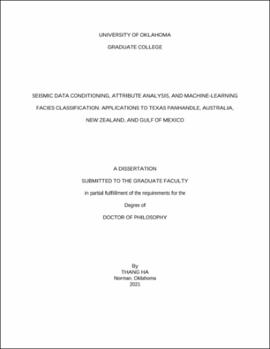| dc.description.abstract | Whether analyzed by a human interpreter or by a machine learning algorithm, 3D seismic interpretation is only as good as the data that goes into it. The goal of seismic processing is to minimize noise and enhance signal to provide the most accurate image of the subsurface. Once imaged, the resulting migrated data volume can be further enhanced to suppress random and cross-cutting coherent noise and to better balance the spectrum to improve vertical resolution. Next, seismic attributes enhance subtle geologic features that may be otherwise overlooked. At this point, skilled human interpreters are very adept at not only seeing patterns in the data, but also in constructing correlations in their brain between multiple attributes and geologic features of interest. Machine learning algorithms are not yet at this point. Several machine learning algorithms require, and many perform better on data that exhibit Gaussian statistics, such that we need to carefully scale the attribute volumes to be analyzed. The application of filters that block and smooth the attribute volume, mimicking what a human interpreter “sees” provide further improvements. In this dissertation, I address most of these data conditioning challenges, as well as adapting and recoding the machine learning algorithms themselves.
Conventional imaging of the shallow targets often results in severe migration aliasing. To improve the interpretation of a shallow fractured-basement reservoir in the Texas Panhandle, I developed a data conditioning technique called constrained conjugate-gradient least-squares migration to the prestack unmigrated data of the study area. I found that constrained conjugate-gradient least-squares migration can increase the signal-to-noise ratio, suppress migration artifacts, and improve seismic inversion results.
Although 3D seismic surveys are routinely acquired, in frontier areas, much of our data consist of a grid of 2D seismic lines. Few publications discuss the application and limitations of modern seismic attributes to 2D lines, and fewer still the application of machine learning. I used a grid of 2D lines acquired over a turbidite channel system and carbonate sequences in the Exmouth Plateau, North Carnarvon Basin, Australia, to address this question. First, I modified 3D data conditioning workflows including nonlinear spectral balancing and structure-oriented filtering, and found that spectral balancing followed by structure-oriented filtering provides superior results. All of the more common attributes perform well, but with analysis of 2D lines providing apparent dip and apparent curvature in the inline direction rather than true dip magnitude and azimuth, and most-positive and most-negative curvature and their strikes. I analyzed coherence, curvature, reflector convergence, and envelope attributes using self-organizing maps and was able to successfully map turbidite canyon, carbonate mounds, and mass-transport complexes (MTCs) in the study area.
Although some attributes exhibit Gaussian statistics, most do not. Although many machine learning algorithms are based on Gaussian statistics, most applications apply a simple Z-score normalization. I therefore compared the results of seismic facies classification of a Canterbury Basin turbidite system when using the traditional Z-score normalization versus one I developed that addresses skewness, kurtosis, and other scaling features in the attribute histogram. I found that logarithmic normalizations of skewed distributions are better input to unsupervised PCA, ICA, SOM, and GTM classification algorithms, but are worse for the supervised learning PNN classification algorithm. In contrast, supervised classification benefits greatly from a class-dependent normalization scheme, where the training data are normalized differently for each class. | en_US |
